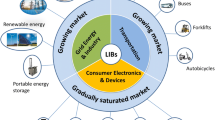Abstract
Operating temperature of lithium-ion battery is an important factor influencing the performance of electric vehicles. During charging and discharging process, battery temperature varies due to internal heat generation, calling for analysis of battery heat generation rate. The generated heat consists of Joule heat and reaction heat, and both are affected by various factors, including temperature, battery aging effect, state of charge (SOC), and operation current. In this article, a series of experiments based on a power-type lithium manganese oxide/graphite battery was implemented under different conditions. The parameters for Joule heat and reaction heat are determined, and the Joule heat, reaction heat as well as total heat generation rate is detailed and analyzed considering the influence of temperature, aging, SOC, and current. In order to validate the accuracy of heat generation rate, a lumped battery heat transfer model is applied to calculate the temperature variation, and the estimated temperature variation shows good correspondence with experimental results under different currents and aging conditions. Due to its simplicity, the temperature variation estimation method is suitable for real time applications.










Similar content being viewed by others
References
Zhang J, Lee J. A review on prognostics and health monitoring of Li-ion battery. J Power Sources. 2011;196:6007–14.
Zhao XW, Zhang GY, Yang L, et al. A new charging mode of Li-ion batteries with LiFePO4/C composites under low temperature. J Therm Anal Calorim. 2011;104:561–7.
Bhide S, Shim T. Novel predictive electric Li-ion battery model incorporating thermal and rate factor effects. IEEE Trans Veh Technol. 2011;60:819–29.
Lu TY, Chiang CC, Wu SH, et al. Thermal hazard evaluations of 18650 lithium-ion batteries by an adiabatic calorimeter. J Therm Anal Calorim. 2013; doi: 10.1007/s10973-013-3137-9.
Lu L, Han X, Li J, et al. A review on the key issues for lithium-ion battery management in electric vehicles. J Power Sources. 2013;226:272–88.
Yang K, An JJ, Chen S. Temperature characterization analysis of LiFePO4/C power battery during charging and discharging. J Therm Anal Calorim. 2010;99:515–21.
Fang K, Chen S, Mu D, et al. The heat generation rate of nickel-metal hydride battery during charging/discharging. J Therm Anal Calorim. 2013;112:977–81.
Bandhauer TM, Garimella S, Fuller TF. A critical review of thermal issues in lithium-ion batteries. J Electrochem Soc. 2011;158:R1–25.
Chen SC, Wan CC, Wang YY. Thermal analysis of lithium-ion batteries. J Power Sources. 2005;140:111–24.
Wu W, Xiao X, Huang X. The effect of battery design parameters on heat generation and utilization in a Li-ion cell. Electrochim Acta. 2012;83:227–40.
Forgez C, Do DV, Friedrich G, et al. Thermal modeling of a cylindrical LiFePO4/graphite lithium-ion battery. J Power Sources. 2010;195:2961–8.
Thomas KE, Newman J. Thermal modeling of porous insertion electrodes. J Electrochem Soc. 2003;150:A176–92.
Andrea D, Meiler M, Steiner K, et al. Characterization of high-power lithium-ion batteries by electrochemical impedance spectroscopy. I. Experimental investigation. J Power Sources. 2011;196:5334–41.
Ecker M, Gerschler JB, Vogel J, et al. Development of a lifetime prediction model for lithium-ion batteries based on extended accelerated aging test data. J Power Sources. 2012;215:248–57.
Viswanathan VV, Choi D, Wang D, et al. Effect of entropy change of lithium intercalation in cathodes and anodes on Li-ion battery thermal management. J Power Sources. 2010;195:3720–9.
Thomas KE, Bogatu C, Newman J. Measurement of the entropy of reaction as a function of state of charge in doped and undoped lithium manganese oxide. J Electrochem Soc. 2001;148:A570–5.
Matthe R, Turner L, Mettlach H. VOLTEC battery system for electric vehicle with extended range. SAE Int J Engines. 2011;4:1944–62.
Battery Test Manual for Plug-In Hybrid Electric Vehicles. Idaho National Laboratory. 2010. http://www.inl.gov/technicalpublications/Documents/4655291.pdf. Accessed 10 May 2013.
Remmlinger J, Buchholz M, Meiler M, et al. State-of-health monitoring of lithium-ion batteries in electric vehicles by on-board internal resistance estimation. J Power Sources. 2011;196:5357–63.
Thomas KE, Newman J. Heats of mixing and of entropy in porous insertion electrodes. J Power Sources. 2003;119–121:844–9.
Dubarry M, Truchot C, Liaw BY. Synthesize battery degradation modes via a diagnostic and prognostic model. J Power Sources. 2012;219:204–16.
Belt J, Utgikar V, Bloom I. Calendar and PHEV cycle life aging of high-energy, lithium-ion cells containing blended spinel and layered-oxide cathodes. J Power Sources. 2001;196:10213–21.
Zheng Y, Han X, Lu L, et al. Lithium ion battery pack power fade fault identification based on Shannon entropy in electric vehicles. J Power Sources. 2013;223:136–46.
Chiang CJ, Yang JL, Cheng WC. Temperature and state-of-charge estimation in ultracapacitors based on extended Kalman filter. J Power Sources. 2013;234:234–43.
Brown D, Landers RG. Control oriented thermal modeling of lithium ion batteries from a first principle model via model reduction by the global Arnoldi algorithm. J Electrochem Soc. 2012;159:A2043–52.
Onda K, Ohshima T, Nakayama M, et al. Thermal behavior of small lithium-ion battery during rapid charge and discharge cycles. J Power Sources. 2006;158:535–42.
Ye Y, Shi Y, Cai N, et al. Electro-thermal modeling and experimental validation for lithium ion battery. J Power Sources. 2012;199:227–38.
Acknowledgements
This research is funded by the MOST (Ministry of Science and Technology) of China (Grant No. 2011AA11A227 and 2010DFA72760) and the MOE (Ministry of Education) of China (Grant No. 2012DFA81190).
Author information
Authors and Affiliations
Corresponding author
Rights and permissions
About this article
Cite this article
Liu, G., Ouyang, M., Lu, L. et al. Analysis of the heat generation of lithium-ion battery during charging and discharging considering different influencing factors. J Therm Anal Calorim 116, 1001–1010 (2014). https://doi.org/10.1007/s10973-013-3599-9
Received:
Accepted:
Published:
Issue Date:
DOI: https://doi.org/10.1007/s10973-013-3599-9




